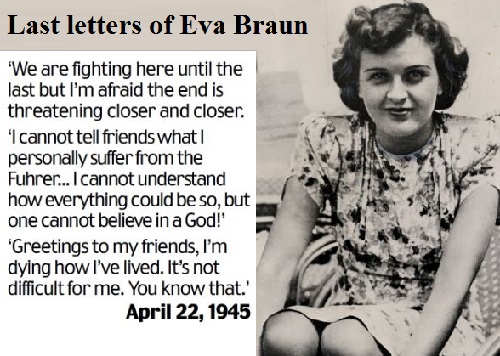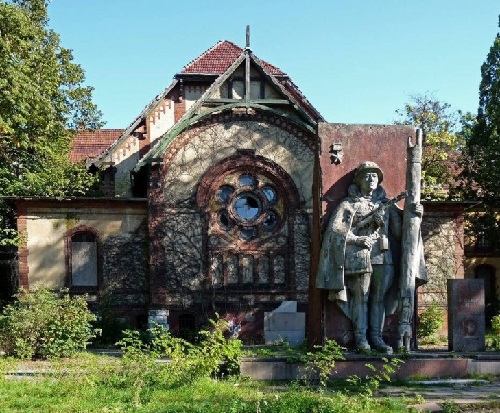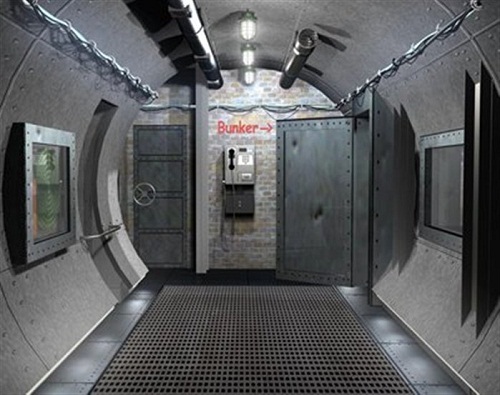Inside Hitler and Eva Braun Bunker
Inside Hitler and Eva Braun Bunker
Russian soldiers fought their way to the heart of Nazism, in a crusade of revenge for the 27 million deaths Hitler’s forces caused in their homeland. 33-year-old LIFE photographer William Vandivert was on the scene, photographing the city’s devastated landscape — and the eerie, almost unfathomable scene inside the bunker where Adolf Hitler spent the last months of his life; where he and Eva Braun were married; and where, just before war’s end, the two killed themselves, on April 30 1945. The photos have been compiled in a LIFE.com gallery for the first time. Bunker was beneath the Reich Chancellery which was reduced to brickdust by Russian artillery shells and Allied bombs.

Russian soldiers and a civilian struggle to move a large bronze Nazi Party eagle that once loomed over a doorway of the Reich Chancellery, Berlin, 1945. not originally published in LIFE
Adolf Hitler’s command center conference room partially burned out by SS troops and stripped of evidence by invading Russians, in bunker under the Reichschancellery after Hitler’s suicide
Not originally published in LIFE. In typed notes that William Vandivert sent to LIFE’s New York offices after getting to Berlin, he described his intense, harried visit to Hitler’s bunker: “These pix were made in the dark with only candle for illumination … Our small party of four beat all rest of mob who came down about forty minutes after we got there.” Above: A 16th century painting reportedly stolen from a Milan museum.

The first of the approximately 20 pages of notes that William Vandivert typed for LIFE’s editors in New York
The first of the approximately 20 pages of notes that William Vandivert typed for LIFE’s editors in New York, describing not only the pictures he took but also the atmosphere pervading his examination of Hitler’s bunker and the Reich Chancellery grounds. (An example of Vandivert’s terse, vivid notations: “… view of chancellery palace … completely bombed, burned and shelled to hell.”)
At the time Vandivert, who died in 1992, reported for LIFE; ‘Almost every famous building in Berlin is a shambles. In the center of town GIs could walk for blocks and see no living thing, hear nothing but the stillness of death, smell nothing but the stench of death.’
Inside Hitler and Eva Braun Bunker

War correspondents examining the arm of sofa stained with blood while one of them uses a candle to search the floor for evidence of suicide in Adolf Hitler’s underground shelter

Burned and scattered papers on desk inside Adolf Hitler’s command bunker where he and his mistress Eva Braun committed suicide

Adolf Hitler and Eva Braun, 1943, kept their affair hidden for many years, but new images collated by Life magazine shed fresh light on their final moments

Vandivert was the first Western photographer to gain access to Hitler’s Fuhrerbunker after the fall of Berlin

Empty jerrycans of gasoline reportedly used by SS Troops to burn bodies of Adolph Hitler & Eva Braun after their suicides in his command bunker

LIFE correspondent Percy Knauth sifting through the dirt & debris in the shallow shell hole where the bodies of Hitler and Eva Braun were thought to have been burned after their suicides, in the garden of the Reichstag

Wreckage, right, inside Adolf Hitler’s command bunker and left, hand touching destroyed hinge of door to Adolf Hitler’s command bunker, burned off by advancing Russian combat engineers

At the Reichstag, evidence of a practice common throughout the centuries: soldiers scrawling graffiti to honor fallen comrades, insult the vanquished or simply announce, I was here. I survived.’

At the Reichstag, evidence of a practice common throughout the centuries: soldiers scrawling graffiti to honor fallen comrades, insult the vanquished or simply announce, I was here. I survived.’

A man on bicycle and young boy going past smashed vehicles and abandoned artillery which fill Oberwallstrasse street, where some of the most bitter fighting for control of Berlin took place
source life.time.com













